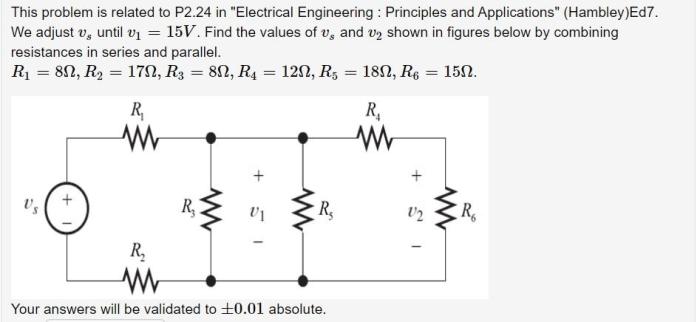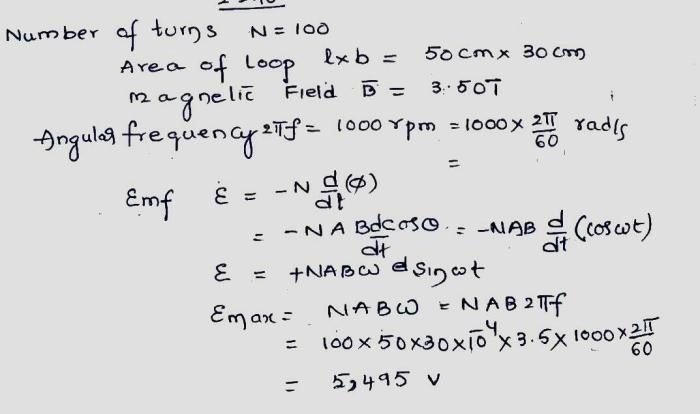Electrical engineering: principles and applications 5th edition – Delving into the intricacies of electrical engineering, the 5th edition of “Electrical Engineering: Principles and Applications” serves as an authoritative guide to the fundamental concepts and practical applications that shape this dynamic field. Embark on an electrifying journey as we explore the principles of circuit analysis, delve into the operation of transformers, unravel the mysteries of electrical machines, dissect the complexities of power systems, and illuminate the paramount importance of electrical safety.
This comprehensive text provides a thorough grounding in the theoretical underpinnings of electrical engineering, equipping readers with the knowledge and skills necessary to navigate the challenges and harness the transformative power of electricity in modern society.
Electrical Circuit Analysis
Electrical circuit analysis involves understanding the behavior of electrical circuits, which are pathways for the flow of electrical current. It encompasses the study of voltage, current, resistance, and power, and the relationships between these quantities. By analyzing circuits, engineers can design and optimize electrical systems for various applications.
Basic Concepts
- Voltage: The electrical potential difference between two points in a circuit, measured in volts (V).
- Current: The flow of electrical charge through a circuit, measured in amperes (A).
- Resistance: The opposition to the flow of current in a circuit, measured in ohms (Ω).
- Power: The rate at which electrical energy is transferred or consumed, measured in watts (W).
Types of Circuits
- Series circuits: Components are connected in a single path, with the same current flowing through each component.
- Parallel circuits: Components are connected in multiple paths, with the voltage across each component being the same.
Methods of Analysis
- Ohm’s law: Relates voltage, current, and resistance in a circuit (V = IR).
- Kirchhoff’s laws: Two laws that describe the conservation of charge and energy in electrical circuits.
Transformers: Electrical Engineering: Principles And Applications 5th Edition

Transformers are electrical devices that transfer electrical energy from one circuit to another through electromagnetic induction. They are essential components in power systems, providing voltage conversion, isolation, and impedance matching.
Principles of Operation
- Mutual inductance: The phenomenon where a changing current in one coil induces a voltage in another coil that is magnetically linked.
- Transformer turns ratio: The ratio of the number of turns in the primary coil to the number of turns in the secondary coil, which determines the voltage transformation.
Types of Transformers
- Power transformers: Used to step up or step down voltage levels in power systems.
- Isolation transformers: Provide electrical isolation between two circuits, preventing the flow of fault currents.
Applications
- Voltage conversion: Transformers can increase or decrease voltage levels to meet the requirements of different devices and systems.
- Isolation: Isolation transformers protect sensitive equipment from electrical hazards by isolating them from the main power supply.
- Impedance matching: Transformers can match the impedance of a source to the impedance of a load, ensuring efficient power transfer.
Electrical Machines
Electrical machines are devices that convert electrical energy into mechanical energy (motors) or mechanical energy into electrical energy (generators). They are widely used in industrial, commercial, and domestic applications.
Principles of Operation
- Generators: Convert mechanical energy into electrical energy by rotating a conductor in a magnetic field.
- Motors: Convert electrical energy into mechanical energy by applying a magnetic field to a current-carrying conductor.
Types of Electrical Machines
- AC machines: Operate on alternating current (AC), with the direction of current and magnetic field reversing periodically.
- DC machines: Operate on direct current (DC), with the direction of current and magnetic field remaining constant.
Applications
- Power generation: Generators convert mechanical energy from prime movers (e.g., turbines) into electrical energy.
- Industrial automation: Motors drive machinery and equipment in factories and industrial processes.
- Consumer appliances: Motors are used in various household appliances, such as refrigerators, washing machines, and vacuum cleaners.
Power Systems
Power systems are complex networks that generate, transmit, and distribute electrical energy to consumers. They involve a wide range of components, including generators, transformers, transmission lines, and distribution networks.
Principles of Operation
- Generation: Electrical energy is generated at power plants using various technologies (e.g., fossil fuels, nuclear, renewable energy).
- Transmission: High-voltage transmission lines carry electricity over long distances with minimal losses.
- Distribution: Local distribution networks deliver electricity to homes, businesses, and industries.
Types of Power Systems
- AC systems: Utilize alternating current (AC), with voltage and current reversing periodically.
- DC systems: Utilize direct current (DC), with voltage and current remaining constant.
Components
- Generators: Convert mechanical energy into electrical energy.
- Transformers: Change voltage levels to facilitate transmission and distribution.
- Transmission lines: Carry electricity over long distances.
- Distribution networks: Deliver electricity to consumers.
Electrical Safety
Electrical safety is paramount to prevent electrical accidents and injuries. It involves understanding the hazards of electricity and implementing appropriate safety measures.
Principles of Electrical Safety
- Hazards of electricity: Electricity can cause electrical shock, burns, and fires.
- Precautions: Avoid contact with live wires, use proper insulation, and maintain electrical equipment regularly.
Electrical Safety Equipment, Electrical engineering: principles and applications 5th edition
- Fuses: Protect circuits from overcurrent by breaking the circuit when current exceeds a safe limit.
- Circuit breakers: Similar to fuses, but can be reset after tripping.
- Ground fault interrupters (GFIs): Detect ground faults and quickly interrupt the circuit to prevent electrical shock.
Electrical Safety Practices
- Workplace safety: Follow established electrical safety procedures, use proper personal protective equipment (PPE), and maintain a safe work environment.
- Home safety: Avoid overloading circuits, use surge protectors, and have electrical systems inspected regularly.
FAQ Summary
What are the key concepts covered in “Electrical Engineering: Principles and Applications, 5th Edition”?
This comprehensive text covers the fundamental concepts of electrical circuits, transformers, electrical machines, power systems, and electrical safety.
How does this book approach the teaching of electrical engineering?
The book adopts a clear and engaging approach, providing a solid theoretical foundation while emphasizing practical applications and real-world examples.
Is this book suitable for both beginners and experienced electrical engineers?
Yes, the book is designed to cater to a wide range of readers, from students seeking a foundational understanding to practicing engineers seeking to expand their knowledge.

